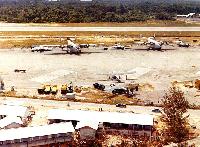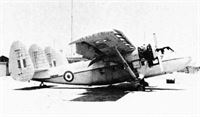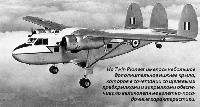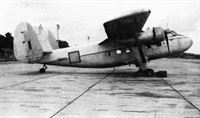
Scottish Aviation Twin Pioneer
Успех высокоплана Pioneer побудил "Scottish Aviation" разработать двухмоторный самолет Twin Pioneer увеличенной грузоподъемности. Самолет сохранил ряд конструктивных отличий первых Pioneer, обеспечивающих высокие взлетно-посадочные характеристики, но отличался трехкилевым хвостовым оперением и вновь спроектированным шасси.
Фюзеляж новой машины имел большие размеры и был приспособлен под перевозку людей и грузов. Самолет также предназначался для использования как санитарный, VIP перевозок, а также для геофизической и фоторазведки.
Первый полет прототип Twin Pioneer с двумя моторами воздушного охлаждения Alvis Leonides 503/8 мощностью по 540 л. с. выполнил 25 июня 1955 года. На серийных Twin Pioneer Series 1 стояли моторы Leonides 514/8 мощностью по 560 л. с. Первый полет серийная машина выполнила 28 апреля 1956 года.
На Twin Pioneer Series 2 устанавливались моторы Pratt & Whitney R-1340-S1H1-G по 600 л. с., на Twin Pioneer Series 3 - моторы Leonides 531. Всего построили 87 самолетов, включая 29 на экспорт и 19 для гражданских заказчиков из Великобритании.
С 1958 года ВВС Великобритании получили 32 Twin Pioneer CC.Mk 1 и семь Twin Pioneer CC.Mk 2. Все самолеты британских ВВС с 1961 года переоснастили более мощными двигателями Leonides 531.
Twin Pioneer британских ВВС применялись в качестве транспортных в Малайе, Адене и на Борнео. Самолет мог брать на борт 13 солдат или 11 парашютистов. Использовали их также в качестве санитарных, бомбардировщиков, фоторазведчиков. Опыт боевого применения привел к появлению вооруженного Twin Pioneer CC.Mk 2. В дополнение к бомбам на внешней подвеске на CC.Mk 2 монтировали два стреляющих вперед пулемета Browning, а в проеме задней двери фюзеляжа мог быть установлен на турели пулемет Bren.
В Малайе и на Борнео, где мобильность войск стала ключевым фактором, самолеты Twin Pioneer оказались незаменимыми для снабжения отрядов, патрулирующих джунгли. Подобно одномоторному Pioneer, Twin Pioneer мог работать с площадок размером 30 x 275 м.
С вооружения частей первой линии Twin Pioneer сняли в 1968 году. Уцелевшие самолеты, из числа летавших в Малайе, передали вновь сформированным ВВС Малайзии, которые эксплуатировали их с 1962 года по 1974 год.
ТАКТИКО-ТЕХНИЧЕСКИЕ ХАРАКТЕРИСТИКИ
Scottish Aviation Twin Pioneer CC.Mk 1
Тип: военно-транспортный самолет
Силовая установка: два мотора воздушного охлаждения Alvis Leonides 531 мощностью по 640 л. с. (564 кВт)
Летные характеристики: максимальная скорость на высоте 610 м - 266 км/ч; практический потолок 6095 м; дальность с максимальной нагрузкой 338 км
Масса: пустого снаряженного 4627 кг; максимальная взлетная 6622 кг
Размеры: размах крыла 23,32 м; длина 13,79 м; высота 3,73 м; площадь крыла 62,24 м2
Вооружение: до 907 кг фугасных или осколочных бомб на внешней подвеске
- Описание
Фотографии
-
Мировая Авиация 232
Регистрационный номер: XM961 [3], G-BBVF [3] Пять эскадрилий британских ВВС (21-я, 78-я, 152-я, 209-я и 230-я) получили на вооружение Twin Pioneer CC.Mk 1. Первой ими была в 1959 году укомплектована 21-я эскадрилья, которая эксплуатировала Twin Pioneer CC.Mk 1 до 1965 года. Эта эскадрилья принимала участие в обеспечении действий британской армии в Радфане.
-
Air-Britain Aeromilitaria 1983-04
Регистрационный номер: FM-1062 [2] Twin Pioneer FM1062 of the Royal Malaysian Air Force was silver with a white top and dark blue trim. The fin was painted in dayglo to assist location in the event of a forced landing in the jungle.
-
Aeroplane Monthly 1994-04 / 1994 UK Aircraft Collections and Museums Guide
Регистрационный номер: XL993 [2] Cosford's Twin Pioneer XL993 at Abingdon in 1968.
-
Air Pictorial 2000-05 / M.Collett - Air Atlantique - diverse charter specialists /Airline Profile/
Регистрационный номер: G-APRS [3], G-BCWF [3], XT610 [3] A unique type in the Historic Flight is Scottish Aviation Twin Pioneer G-BCWF, carrying the earlier registration ’PRS and painted in ETPS colours.
-
Aeroplane Monthly 1994-02 / J.Stroud - Pioneers /Post-war propliners/
Регистрационный номер: VH-EVB This Australian Twin Pioneer, owned by Capricorn Air and operated on scenic flights from Bankstown, New South Wales, was photographed by STUART HOWE in 1988.
-
Aviation Historian 14 / J.Pote - New Year on Skyline Ridge
Регистрационный номер: XW-PBP, PI-C434 Illustrating the primitive nature of the airstrip at Sam Thong, this photograph shows Scottish Aviation Twin Pioneer XW-PBP (c/n 567) at Lima Site 20 on January 9, 1966. Although the aircraft is painted in Philippine Air Lines colours, and was indeed registered to the airline as PI-C434, it never served with the company. It was acquired by CIA cover airline Bird & Sons in December 1963 before being transferred to another CIA surrogate, Continental Air Services Inc, in September 1965. It was damaged beyond repair in a thunderstorm at Vientiane in March 1968
-
Air Pictorial 2000-05 / M.Collett - Air Atlantique - diverse charter specialists /Airline Profile/
Some of the diverse types undergoing maintenance in one of Air Atlantic’s hangars, including Cessna 402B G-NOSE in the foreground and the Twin Pioneer at the rear.
Другие самолёты на фотографии: Cessna 411/401/402/421/414/404 - США - 1962
-
Мировая Авиация 44
Лабуан стал в ходе конфликта главной базой британской авиации на Борнео. На фотографии можно видеть транспортные самолеты Beverley и Twin Pioneer, а также перехватчики Javelin и бомбардировщики Canberra.
Другие самолёты на фотографии: Blackburn Beverley / B-101 - Великобритания - 1950English Electric / BAE Canberra - Великобритания - 1949Gloster Javelin - Великобритания - 1951
-
Air Pictorial 1959-09 / Spotter's Notebook
Регистрационный номер: G-AOEN [3] The first production Scottish Aviation Twin Pioneer (G-AOEN) now completed as a Series III.
-
Air Pictorial 1955-08 / Air Pictorial's photo-review
SCOTTISH AVIATION TWIN-PIONEER. First flown on 25th June the Twin Pioneer is an attempt to produce a tough, multi-purpose feeder-liner or military aircraft able to operate into or out of small fields. Started as a private venture and later given some official support, the Twin Pioneer incorporates many of the features proven on the Pioneer 2. Originally intended to have a single fin, the prototype has now appeared with triple fins.
Salient features: A high-wing monoplane, the Twin Pioneer has slab-sided, flat-bottomed fuselage with blunt nose and stepped cockpit. There is marked upsweep on the rear fuselage. The wings have rectangular outer sections while the inner sections have taper on the trailing edge. The radial engines are underslung and the nacelles do not extend beyond the trailing edge. The wings have large high-lift flaps and leading-edge slots along the outer sections. Main undercarriage legs are connected to the fuselage by triangular stub wings. Braced struts extend from the undercarriage legs to the outer wing sections. The main legs each carry twin wheels and there is a fixed tailwheel. In addition to the central fin , there are twin oval end plate fins. -
Aeroplane Monthly 1990-12 / M.Oakey - Grapevine
Регистрационный номер: G-BCWF [3], G-APRS [3], XT610 [3] Fancy being a part-owner of this Scottish Aviation Twin Pioneer?
-
Air Pictorial 1957-09 / J.Stevens - Farnborough 1957
The Twin Pioneer;
-
Aeroplane Monthly 1994-02 / J.Stroud - Pioneers /Post-war propliners/
Регистрационный номер: G-APRS [3], G-BCWF [3], XT610 [3] G-APRS, used by Sierra Leone Airways, was a Series 3 aeroplane which went to the Empire Test Pilots School at Farnborough as XT610.
-
Air Pictorial 1958-01
Регистрационный номер: G-APHX Twin Pioneers, G-APHX and 'HY, are now operated in Kuwait by B.I.A.L. on behalf of the Kuwait Oil Co. and are used for survey work and the transport of mining equipment to inaccessible areas.
-
Air Pictorial 1958-03
Регистрационный номер: G-APIR The modern microscopic markings carried by the newest Twin Pioneer G-APIR.
-
Air Pictorial 1955-10 / J.Stevens - Farnborough 1955
The leading-edge slats of the Twin Pioneer.
-
Air Pictorial 1955-08 / The journal of a roving spotter
Регистрационный номер: G-ANTP [2] The Scottish Aviation Twin Pioneer flew for the first time on 25th June 1955 (not 24th June as has been variously reported elsewhere). It is registered G-ANTP.
-
Aeroplane Monthly 1994-02 / J.Stroud - Pioneers /Post-war propliners/
Регистрационный номер: G-ANTP [2] The prototype Scottish Aviation Twin Pioneer, G-ANTP. In 1959 ’TP was converted to Series 3 standard.
-
Air Pictorial 1955-10 / J.Stevens - Farnborough 1955
The Scottish Aviation Twin Pioneer.
-
Aeroplane Monthly 1977-06 / J.Griffin - Portsmouth Airport 1932-1973
Регистрационный номер: G-APHY [3] One of the last residents at Portsmouth was this J F Airlines Scottish Aviation Pioneer, G-APHY, seen here taking off from its base in September 1971.
-
Aeroplane Monthly 1974-01
Регистрационный номер: G-APHY [3] Scottish Aviation Twin Pioneer, G-APHY, of Flight One, photographed recently by Air Portraits
-
Aeroplane Monthly 1994-02 / J.Stroud - Pioneers /Post-war propliners/
Регистрационный номер: G-APHY [3] Former Kuwait Oil Company Twin Pioneers G-APHX and ’HY returned to the UK in 1969 and were subsequently put into service with Portsmouth-based J F Airlines. Later still, in 1973, both passed to Flight One Ltd at Staverton.
-
Aeroplane Monthly 1994-02 / J.Stroud - Pioneers /Post-war propliners/
Регистрационный номер: G-APLW, VR-OAG Twin Pioneer G-APLW went to Borneo Airways as VR-OAG.
-
Aeroplane Monthly 1994-02 / J.Stroud - Pioneers /Post-war propliners/
Регистрационный номер: G-AOEN [3] Twin Pioneer G-AOEN flying at the 1956 SBAC at Farnborough in the livery of de Kroonduif. The author had a 26min flight in ’EN at the show.
-
Air Pictorial 1956-10 / J.Stevens - Farnborough Round-up
Регистрационный номер: G-AOEN [3] TWIN PIONEER (G-AOEN) takes off at steep angle to reveal slats, flaps and new "acorn" on wing struts intersection .
-
Air Pictorial 1957-10 / J.Stevens - S.B.A.C. 1957
Регистрационный номер: G-AOEO [3] Scottish Aviation Twin Pioneer (G-AOEO; third production model; SAL demonstrator);
-
Aeroplane Monthly 1994-02 / J.Stroud - Pioneers /Post-war propliners/
Регистрационный номер: G-APPH, VH-AIS Series 3 Twin Pioneer G-APPH went to Iraq Petroleum Transport and later became Australian Iron and Steel Co’s VH-AIS Yampi Pioneer.
-
Aeroplane Monthly 1994-02 / J.Stroud - Pioneers /Post-war propliners/
Регистрационный номер: VR-OAE Borneo Airways’ Twin Pioneer Series 1 VR-OAE over Prestwick.
-
Jane's All the World Aircraft 1964 / 01 - Aircraft
Регистрационный номер: OE-BHV Scottish Aviation Twin Pioneer Series 3 owned by the Austrian State Department of Survey
-
Aeroplane Monthly 1994-02 / J.Stroud - Pioneers /Post-war propliners/
Регистрационный номер: PI-C430 Philippine Air Lines’ five Pratt & Whitney-powered Twin Pioneer Series 2 aircraft, with PI-C430 nearest.
-
Aeroplane Monthly 1988-04 / M.Oakey - Grapevine
Регистрационный номер: VH-EVC From Australia comes the shot of Scottish Aviation Twin Pioneer VH-EVC, currently under restoration at Bankstown before joining its sister ship 'EVB as a luxury charter aircraft with Capricorn Air Services.
-
Air-Britain Aeromilitaria 1983-04
Регистрационный номер: XL966 [2] The first Twin Pioneer, XL966, outside the Scottish Aviation factory at Prestwick
-
АвиаМастер 2004-04 / М.Жирохов, А.Котлобовский - Небесные войны Индонезии /Горячая точка/ (3)
"Твин Пайонир" - основная "рабочая лошадь" английской ВТА в Малайзии.
-
АвиаМастер 2004-04 / М.Жирохов, А.Котлобовский - Небесные войны Индонезии /Горячая точка/ (3)
"Твин Пайониры" и "Биверли" в Сингапуре.
Другие самолёты на фотографии: Blackburn Beverley / B-101 - Великобритания - 1950
-
Air-Britain Aeromilitaria 1987-01
Регистрационный номер: XM791 Ready for a storm, Twin Pioneer XM791 of 152 Squadron picketed with two refuellers as a windbreak
-
Air-Britain Aeromilitaria 1983-04
Регистрационный номер: XM939 [2] XM939 of No.209 Squadron at Seletar in August 1966 with sand, brown and black colour scheme
-
Air-Britain Aeromilitaria 1983-04
Регистрационный номер: XL993 [2] The last Twin Pioneer XL993 at Abingdon, now preserved for the Royal Air Force Museum
-
Air-Britain Aeromilitaria 1983-04
Регистрационный номер: XM289 XM289, formerly of 162 Squadron, derelict at Muharraq in May 1969
-
Air-Britain Aeromilitaria 1983-04
Регистрационный номер: XL966 [2] Twin Pioneer XL966 at the 1958 SBAC Display at Farnborough
-
Aeroplane Monthly 1990-01 / Personal album. Military
Регистрационный номер: XM962 RAF Scottish Aviation Twin Pioneer CC.1 XM962 pictured at Kuching, Sarawak on September 22, 1963. This 209 Sqn “Twin Pin" flew supply missions in Borneo during the confrontation with Indonesia in 1962-66. Introduced into RAF service in 1958, the Twin Pioneer did valuable service in the Middle East, Far East and Kenya before being retired from front-line duties at the end of 1968. In the foreground of this picture are two Army Auster AOP.9s.
Другие самолёты на фотографии: Auster AOP.9 - Великобритания - 1954
-
Aeroplane Monthly 1999-06 / Skywriters /Readers' letters/
Регистрационный номер: XM939 [2] Twin Pioneer XM939 of 78 Sqn climbs out of Monk’s Field, Aden, a forward arms post near the Yemeni frontier.
-
Мировая Авиация 232
На Twin Pioneer имелось небольшое дополнительное нижнее крыло, которое в сочетании со щелевыми предкрылками и закрылками обеспечивало великолепные взлетно-посадочные характеристики.
-
Aeroplane Monthly 1979-12
Регистрационный номер: XM961 [3], G-BBVF [3] The picture, taken by a Flight photographer, shows a Scottish Aviation Twin Pioneer C.C.2 of 21 Squadron, RAF, during supply-dropping exercises at the HQ of the School of Land/Air Warfare, Old Sarum, in July 1950.
-
Aeroplane Monthly 1986-01 / 1986 UK Aircraft Collections and Museums Guide
Регистрационный номер: XM961 [3], G-BBVF [3] Scottish Aviation Twin Pioneer XM961/G-BBVF;
-
Jane's All the World Aircraft 1980 / Encyclopedia of Aviation - Aircraft A-Z - v5
Scottish Aviation Twin Pioneer Series 3s for Malaya.
-
Air-Britain Aeromilitaria 1983-04
Регистрационный номер: FM-1062 [2] FM1062 of the Royal Malaysian Air Force
-
Air Enthusiast 1971-08 / ??? - Jungle Fliers of the Rubber State
Регистрационный номер: FM-1001 [2] The RMAF's first aeroplane, Scottish Aviation Twin Pioneer FM1001, was named Raja Wali and was followed by 13 more of the same type. They have now been replaced in the transport role by Handley Page Heralds and DHC Caribou.
-
Air-Britain Aeromilitaria 1988-03
Регистрационный номер: FM-1001 [2] Twin Pioneer FM1001 behind bars, or more precisely natty wrought iron fences, at the Malaysian National Museum in Kuala Lumpur. The exotic architecture makes a better background than the usual hangars and clutter of an airfield.
-
Aeroplane Monthly 1994-02 / J.Stroud - Pioneers /Post-war propliners/
Twin Pioneers in the final-assembly and engine-installation shop at Prestwick Airport in the late Fifties.
-
Air Pictorial 1959-09
Регистрационный номер: G-AOER This photograph, supplied by A. D. Robb, depicts the Twin Pioneer (G-AOER) owned by Rio-Tinto Finance and Exploration Ltd.
-
Air Pictorial 1959-09
The photos show the unusual Mullard magnetometer installations at the wingtips.
-
Air Enthusiast 2003-09 / D.Stern - Tundra retriever
The Twin Pioneer, 'The Thing', being pathed up at Pilot Point airstrip.
-
Air Enthusiast 1996-05 / Round-Out
Twin Pioneer c/n 582 started off life with the Royal Malaysian Air Force in 1963. Now, somewhat forlorn, in British Columbia, a new life awaits.
-
Air Enthusiast 1996-05 / Round-Out
Details of damage to the starboard tailplane and fin.
-
Aviation Historian 16 / K.Honey - In the Land of Black Gold
Регистрационный номер: G-AOEO [3] The wreckage of Scottish Aviation Twin Pioneer G-AOEO in the Libyan desert shortly after its crash in December 1957.
-
Aviation Historian 16 / K.Honey - In the Land of Black Gold
The forlorn sight of the Twin Pin’s almost-complete port wing some 100yd from the main wreckage. The forward tube of the V-brace structure holding the lift strut to the outer panel of the wing had failed owing to metal fatigue.
-
Aeroplane Monthly 1994-02 / J.Stroud - Pioneers /Post-war propliners/
Регистрационный номер: G-AOEO [3] KEITH WOODCOCK’S painting shows Twin Pioneer G-AOEO in Swissair livery.
-
Aeroplane Monthly 1988-12 / P.Masefield - Wren
Excerpt from Men and machines at the 1960 SBAC Display.
-
Air-Britain Aeromilitaria 1983-04
Twin Pioneer
-
Jane's All the World Aircraft 1964 / 01 - Aircraft
Scottish Aviation Twin Pioneer Series 3 light transport
-
Air Pictorial 1955-08 / Air Pictorial's photo-review
SCOTTISH AVIATION TWIN-PIONEER. Data: Manufacturer: Scottish Aviation Ltd., The Airport, Prestwick, Scotland. Power: two 570-h.p. Leonides 502/4 radials. Accommodation: sixteen passengers and one or two crew. Dimensions: span 76 ft . 6 in .; length 45 ft. 1 in .; height 13 ft. 8 in. Weights empty 9.075 lb.; loaded weight 13,500 lb. Performance: maximum speed 180 m.p.h. at 1,750 ft.; maximum continuous cruise 174 m.p.h.; maximum range 620 miles.
-
Air Pictorial 1959-09 / Farnborough Directory
SCOTTISH AVIATION TWIN PIONEER: Illustrated here in standard form but to be seen at Farnborough in its Series III version with wingtip-mounted electro-magnetic units, the Twin Pioneer III is powered by two 640-h.p. Alvis Leonides 531/8 engines. Overall dimensions are: Span 76 ft. 6in.; length 45 ft. 3 in.; height 13 ft. 8 in.; wing area 670 sq. ft.
-
Air Pictorial 1957-11
AGGRESSIVE PIONEER. The Military Twin Pioneer is the first twin-engined, fixed-wing, STOL aircraft to be designed for military purposes. It can be used for communication, transport, paratrooping, supply dropping, bombing and other duties.
- Фотографии































































